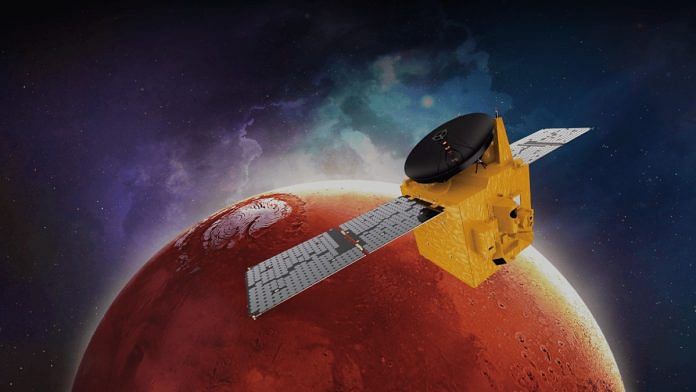Bengaluru: The United Arab Emirates launched the country’s first interplanetary mission, bound for Mars at 1:58 am local time (3:28 am IST) on Monday, 20 July. The Emirates Mars Mission consists of an orbiter called Hope or Al Amal in Arabic and will study Martian atmosphere.
The Hope probe was built by the Mohammed bin Rashid Space Centre in collaboration with University of Colorado Boulder, Arizona State University and University of California, Berkeley.
The mission launched from Japan’s Tanegashima Space Center at 6:58 am Japan local time and is expected to reach Mars in February 2021, marking the 50th anniversary of the Emirates’ union. The mission was reportedly planned and executed with help from ISRO.
Also read: Catch a comet sighting in India as NEOWISE remains visible through July into August
Objectives of the mission
The hexagon-shaped Hope orbiter weighs 1,350 kg and is the size of an SUV. It is currently orbiting Earth before heading out to Mars. Upon reaching its destination, the spacecraft will probe the atmosphere around Mars to understand climate dynamics and the weather map, including the dynamics of hydrogen and oxygen through multiple layers of the atmosphere and how these gases escape into space.
It consists of a thermal infrared spectrometer to study the lower atmosphere and its temperature gradients, a high-resolution camera that can image particles like water, ice and dust across visible and UV bands and a UV spectrometer that will measure gas concentrations in the atmosphere. The mission is planned for two years.
The Mohammed Bin Rashid Space Centre (MBRSC) has so far launched three satellites, DubaiSat-1 & 2, and KhalifaSat, as well as a cubesat, Nayif-1, which flew on PSLV’s historic 104 satellite launch in 2017.
The Mars mission was announced in 2014 and the name was selected from citizen nominations and voting. The project is headed by Omran Sharaf and the lead science investigator is Sarah Amiri. Interestingly, three of the core nine leads for this mission are women.
“This is the future of the UAE,” Amiri, who is also the minister of state for advanced sciences, told Dubai TV from the launch site.
Also read: Why Indian space start-ups are feeling forced to set up base abroad
Emirati space plan
The UAE has been steadily making progress in expanding into space as a part of its knowledge-based economy. The first Emirati to go to space, Hazza al-Mansouri, flew in September last year as part of a three-member crew, to the International Space Station, where he became the first Arab on board.
The UAE plans to build a human settlement on Mars by 2117. To facilitate training and research, the country plans to build a ‘science city’ in the deserts of Dubai to simulate Martian conditions.
With plans to mine outside of Earth, the UAE is starting to invest heavily in space tourism and has signed an MoU with Richard Branson’s Virgin Galactic, which is developing suborbital flights for future tourists.
There are two more Mars missions scheduled this month. Tianwen-1, the second attempt from China (after Fobos-Grunt failed to launch in 2011) will consist of an orbiter, lander and rover, and is scheduled to launch on 23 July. Mars 2020 from NASA will launch the Perseverance rover and the Ingenuity helicopter drone on 30 July.
Mars launches by multiple countries coincide as the launch window opens up only every 26 months. Launching during this window ensures spacecraft take the least amount of time to reach our neighbouring planet, and a delay during one launch window will result in the launch being pushed by at least two years.



